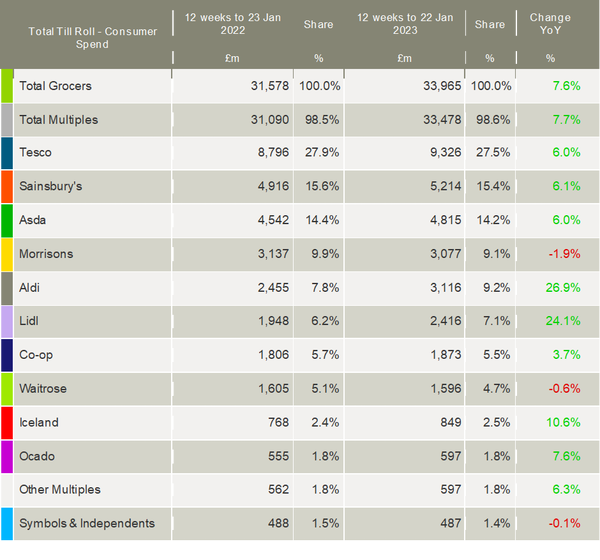Latest data from Kantar shows grocery price inflation hit a record 16.7% in the four weeks to 22 January 2023 – the highest level since the research firm started tracking the figure in 2008. Overall, take-home grocery sales rose by 5.7% during the month and 7.6% over the last 12 weeks, suggesting a significant fall in volumes as cash-strapped consumers reined in their spending.
“Late last year, we saw the rate of grocery price inflation dip slightly, but that small sign of relief for consumers has been short-lived,” said Fraser McKevitt, head of retail and consumer insight at Kantar.
“Grocery price inflation jumped a staggering 2.3 percentage points this month to 16.7%, flying past the previous high we recorded in October 2022. Households will now face an extra £788 on their annual shopping bills if they don’t change their behaviour to cut costs.”
He noted that competition in the grocery sector is as intense as it’s ever been as retailers strive to retain shoppers. Supermarkets have been doing this by boosting their own-label ranges, with sales of these lines growing by 9.3% in January, well ahead of branded alternatives which were up by just 1.0%.
McKevitt said: “Across the market, the move is towards everyday low pricing, with many supermarkets offering price matching and using their loyalty schemes to help shoppers save. As a result of this push, the proportion of spending on promotions has fallen to its lowest level since at least 2008 this month, exaggerating the usual post-Christmas drop-off in deals.
“Aldi, Waitrose and Lidl’s efforts seem to have been particularly well received by shoppers. Our latest customer satisfaction data shows that Aldi scores best on pricing and overall value for money, while Waitrose stands out for knowledgeable staff, product quality and clean shops. Meanwhile, Lidl delivers on easy access to stores and on-shelf availability.”
Kantar’s data shows Aldi was the fastest growing grocer for the fourth month in a row this period, with sales 26.9% higher year-on-year. It now holds 9.2% of the market. Lidl’s sales jumped by 24.1%, putting its market share at 7.1%.
Sales growth was similar at Tesco, Sainsbury’s and Asda, up around 6%. Although its sales fell by 1.9%, Morrisons’ performance has continued to improve for the eleventh month in a row and its market share stabilised at 9.1%. Waitrose continued to struggle, down 0.6%.
Iceland’s share increased by 0.1 percentage point to 2.5%, driven by an annual sales rise of 10.6%. Ocado matched the market’s growth rate at 7.6%, well above overall online sales which were down 0.7%.

NAM Implications:
- As consumers become accustomed to own-label…
- …so the ‘mystique’ surrounding the brand premium diminishes…
- (See O/L sales up 9.3% in January, vs. branded alternatives, up 1.0%, says it all…)
- …for your products in Aldi, Lidl and/or Waitrose.
- Key that you conform to what makes these retailers good:
- Aldi scores best on pricing and overall value for money
- Waitrose stands out for knowledgeable staff, product quality and clean shops
- Lidl delivers on easy access to stores and on-shelf availability
- Meanwhile, combined shares of Aldi & Lidl behind Tesco but ahead of all other mults…
- Begging the obvious question for any supplier not listed by the discounters…




